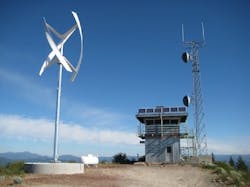Credit: UGE
A funny thing happened to Urban Green Energy (UGE) on the way to becoming a small wind turbine manufacturer.
The New York company discovered that demand was limited for its product on a stand-alone basis. But combine small wind turbines with solar, storage and some intelligence – into a remote microgrid – and the market is vast.
This is especially true as the cell phone comes to permeate far corners of the world. Cell phones require telecommunication towers. Telecommunication towers require electricity. With no central grid connection – or an unstable one – remote outposts once depended largely on expensive and polluting diesel generators. Now renewable microgrids offer a less expensive, reliable and clean alternative.
“This has become a gigantic market in the last three years,” said David Droz, senior project manager for UGE, which has added solar, outdoor lighting, and microgrid electronics, siting and installation to its product offerings.
And the market is about to become bigger. Google announced this week a cell phone campaign to reach “the next five billion” – those without smart phones. (About 1.75 billion people do have smart phones now.) To that end, Google has developed a less expensive Android that it has introduced into India and plans to bring before year’s end to Indonesia, the Philippines and South Asia (Bangladesh, Nepal, Pakistan, and Sri Lanka.)
For UGE, this means expansion of a market that is already keeping the company busy.
“We began working on this internally two years ago. A lot of the customer inquiries we were getting were from telecom companies asking for wind turbines. These were customers that were experiencing some of the highest levelized energy cost in the world. They were burning diesel 24/7,” Droz said.
Keep up on stories like this by following us on Twitter @MicrogridNews.
Wind doesn’t blow consistently everywhere, hence its limits as a resource for remote microgrids. But when combined with solar, storage and intelligence, the microgrid offers a high level of reliability.
Credit: UGE
Of course, the needs for each site vary dramatically. So UGE not only provides the microgrid, but also assesses the location to understand the best combination of wind, solar, storage and monitoring and control to achieve lowest possible levelized costs under a 10-year contract.
Working in remote terrain is not always easy. For example, in January UGE and Self Energy Pacific installed a hybrid wind/solar system for a telecommunications site accessible only by helicopter in the South Pacific. All of the equipment had to be delivered by helicopter to Île Ouen island, part of New Caledonia. But once installed, the microgrid spared telecommunication company OPT the arduous and expensive task of refueling the site by helicopter.
Now the telecom towers are powered by a fuel free systems, a 6-kW photovoltaic system, 1-kW wind turbine, and a battery storage bank. The system proved its hardiness when a severe storm hit and the power never went out.
UGE recently announced a $400,000 order to provide hybrid microgrids for remote telecom towers for an unnamed government entity for use in the Middle East – another growing market.
Credit: UGE
This adds to the renewable energy projects UGE has worked on in more than 90 countries since it was founded in 2008.
UGE’s story is entrepreneurial tale made for retelling. Sometimes the first idea – in this case small wind – offers only limited potential. But keep your eyes open, the market may be signaling something far larger afoot, in this case the fast-growing telecom industry’s need for remote microgrids.
Side Note:
UGE isn’t always Indiana Jones-ing to install microgrids in far off locations. The public company also is involved in high profile US projects, among them the Whole Foods Market microgrid recently featured here at MicrogridKnoweldge.com.
UGE provided the Brooklyn store’s hybrid wind and solar streetlights and its renewable electric vehicle charging stations
“In the event of a regional power outage, the Sanya SLS streetlights will continue operating, simply by gathering the energy freely available in the wind and sun,” said UGE’s Ryan Gilchrist, UGE’s associate director, enterprise division.
UGE also was selec ted by Kilroy Realty to design and supply the solar energy system at Dropbox’s new LEED Platinum San Francisco office.







